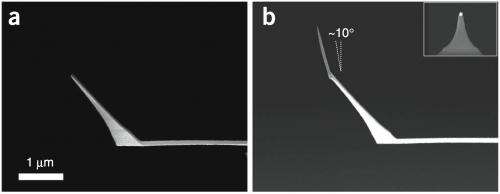The guide to biomolecular movie-making

High-speed atomic force microscopy (HS-AFM) is providing the means to produce dramatic footage of moving biomolecules, and scientists at Kanazawa University leading the field.
Toshio Ando and co-workers at Kanazawa University have developed and used HS-AFM to increase our understanding of several protein systems through microscopic movies of unprecedented spatial and temporal resolution. The team have now published a guide to video recording these important cell components, so that other researchers can benefit from this unique technology.
To produce an image, HS-AFM acquires information on sample height at many points by tapping the sample with the sharp tip of a tiny cantilever. Depending on the application, this might involve recording the amplitude and phase of oscillations, or the resonant frequency of the cantilever.
Ando and co-workers use very small cantilevers that afford 10 to 20 times the sensitivity of larger, conventional cantilevers. Copies of their home-made apparatus are now commercially available through the manufacturer Research Institute of Biomolecule Metrology Co., Ltd. (RIBM) in Tsukuba, and record images at least ten times more quickly than their competitors.
In their paper, published in Nature Protocols, the researchers describe how to prepare substrates to hold samples during HS-AFM, and provide advice on the best ways to take advantage of the equipment. These methods have so far enabled the team to record cargo-carrying proteins 'walking' on cell filaments, the rotational motion of motor proteins that provide energy in cells, and the hydrolysis of cellulose. By sharing their experiences of pioneering work in this field, the entire research community will benefit, and learn ever more about the dynamics and structure of vital biological components.
More information: Uchihashi, T. et al., Guide to video recording of structure dynamics and dynamic processes of proteins by high-speed atomic force microscopy. Nature Protocols, 7(6), 1193–1206, (2012).
Provided by Kanazawa University





















